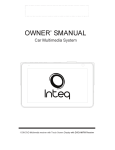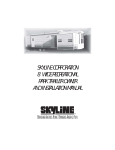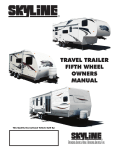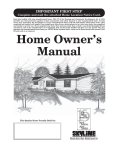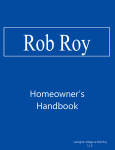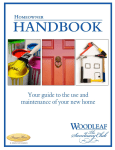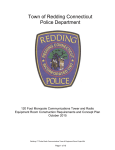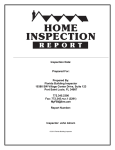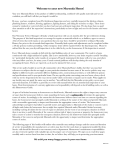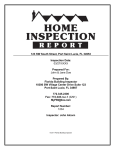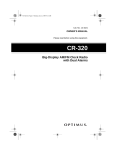Download skyline corporation recreational vehicle park trailer owner and
Transcript
SKYLINE Skyline Corporation Recreational Vehicle Park Trailer Owner and Installation Manual We’re delighted that you chose to invest in a Skyline-built park trailer. It is designed and constructed to make park trailer living as safe and carefree as possible. And we won’t be satisfied until you’re completely happy with every aspect of your new park trailer. This manual can help assure that happiness. We urge you to read it carefully and follow its instructions and recommendations. We also urge you to read the other manuals and information about the appliances in your new trailer. This information should be kept where it will be available for easy reference. To further ensure your satisfaction: 1. Your park trailer is inspected by your dealer after it leaves the factory and before it is delivered to you. 2. Upon taking delivery of your park trailer, have your dealer go over your trailer with you and instruct you concerning the appliances and other functional components. As we’re sure you understand, even the best built trailers occasionally require service. So if service is needed, please see the “How to Obtain Service” instructions on page 2 of this Manual. All of us at Skyline join with your dealer in wishing you every happiness in your new park trailer. SKYLINE CARES ABOUT YOU Skyline is a leader in the recreational vehicle and manufactured housing industries because Skyline cares about its owners. And the proof of that caring is the exclusive sixpoint program that protects your investment in your Skylinebuilt trailer. 1. Research and development. Skyline-built park trailers are The heating, cooling, electrical and other systems and appliances in your park trailer must be operated and maintained ONLY as specified in this manual and in the other manuals furnished with your park trailer. These manuals must be followed for good performance and to assure your safety, so carefully read these manuals immediately. Obtain qualified planned by a complete staff of professional engineers and help whenever recommended or whenever you are in doubt. designers. Be sure you clearly understand how to operate any system 2. Code construction. Every park trailer built by Skyline meets or exceeds code standards and features quality components including name-brand appliances. 3. Recreational Park Trailer Industry Association. The RPTIA seal on your park trailer means that the park trailer before you try. If you are at all uncertain, contact your dealer, the Skyline factory, the system or appliance manufacturer’s local representative or Skyline’s Director of Consumer Affairs BEFORE you try to operate any system or appliance. Please meets the requirements of ANSI A119.5 Standard for read with special care the Emergency Exits section of this Recreational Park Trailers and that an RPTIA approved manual. Also, please read all instructions, notices and third party inspection agency has inspected the park trailer warnings on the trailer, its systems and appliances. FAILURE during production. TO FOLLOW THESE IMPORTANT PRECAUTIONS MAY 4. Full 15-month warranty. It’s the no-nonsense guarantee printed in this manual. We urge you to read it. 5. Full field service. Skyline and its dealers are pledged to back up the warranty with prompt, effective service that takes care of problems quickly and effectively. 6. Financial strength. Skyline is one of America’s soundest companies financially. You can rely on Skyline today and tomorrow. 2 IMPORTANT SAFETY MESSAGE RESULT IN SERIOUS INJURY OR DEATH. If you sell your park trailer, please make certain that this manual and other manuals furnished with your trailer are given to the new owner. Full 15-Month Warranty Manufacturing defects reported to Skyline within one year and 10 days after original retail delivery of your new Park Trailer by an authorized dealer will be corrected without charge and within reasonable times. Excluded are misuse (including lack of reasonable maintenance), minor imperfections, alterations, and dealer or owner improper transportation, installation or hookup. This warranty gives you specific legal rights. You may have other rights which vary from state to state. Skyline’s suppliers often provide additional warranties on their components beyond the Skyline factory bumper-to-bumper warranty. For example — the range, water heater, furnace and convertor carry two-year supplier warranties while the air conditioner, refrigerator, microwave and awning carry three-year warranties. The one-piece roof carries a 12-year warranty. Ask your dealer for full details. How to Obtain Service Your continued satisfaction with your park trailer is of 5. In those rare cases in which your dealer and the utmost importance to Skyline. Please follow these steps for factory service representative have been unable fast, efficient warranty service. to resolve the problem, write the Director of Consumer Affairs, Skyline Corporation, P.O. Box 743, 1. Inspect your park trailer thoroughly to determine exactly what service is required. Elkhart, Indiana 46515 or email to: CRELATIONS@ SKYLINECORP.COM. Include the complete serial 2. Make a list of the required service. Be sure to sign it. number of your park trailer, your telephone number 3. Call, write or visit your dealer. and a complete list of required manufacturer’s warranty service. Your request will receive prompt If your request is not resolved to your satisfaction, attention. make sure it is brought to the attention of the owner or general manager of the dealership. They will obtain factory assistance, if needed. Note: Your appliances are warranted both by the All service under your Skyline warranty will be performed without charge for either parts or labor. Whether service is performed by the dealer, the factory, or others, Skyline accepts appliance manufacturer and by Skyline. All appliances final responsibility for fulfillment of all its warranty obligations. furnished with your park trailer are “name-brands,” and the Skyline will use its best efforts to see that all manufacturer’s manufacturer may have a service facility near you. If so, you warranty service is completed as expeditiously as possible. may be able to obtain even faster service by requesting service directly from the appliance manufacturer. Warranty service requests must be made within the warranty period and should ordinarily go to your dealer. 4. If your request has not been resolved to your satisfaction within a reasonable time, write (include the complete serial number of your park trailer and your telephone number with a copy of your list of required service) and/or call the factory service representative at: 3 Table of Contents WARRANTY...............................................................................................................................................................................................................3 REPORTING SAFETY DEFECTS ............................................................................................................................................................................3 HOW TO OBTAIN SERVICE......................................................................................................................................................................................3 PARK TRAILER OWNER INFORMATION.................................................................................................................................................................5 GENERAL MAINTENANCE................................................................................................................................................................................... 6-8 GAS SYSTEMS & APPLIANCE INFORMATION...................................................................................................................................................7, 8 AIR QUALITY, VENTILATION AND CONDENSATION..............................................................................................................................................9 FIRE SAFETY ...................................................................................................................................................................................................10, 11 EMERGENCY PROCEDURES ...............................................................................................................................................................................11 SETUP PROCEDURE .......................................................................................................................................................................................11-18 SITE PREPARATION ..............................................................................................................................................................................................11 INSTALLATION INSPECTION CHECKLIST............................................................................................................................................................12 SUPPORT REQUIREMENTS..................................................................................................................................................................................13 BLOCKING PROCEDURE ......................................................................................................................................................................................14 TIE-DOWN INSTRUCTIONS ............................................................................................................................................................................15, 16 UTILITY HOOKUP AND TESTING . ........................................................................................................................................................................17 Water . ..............................................................................................................................................................................................................17 Drainage . .........................................................................................................................................................................................................17 Gas..............................................................................................................................................................................................................17, 18 Electrical............................................................................................................................................................................................................18 Heating .............................................................................................................................................................................................................18 INSTALLATION OF EXTERIOR LIGHTING FIXTURES .........................................................................................................................................19 WINTERIZE CHECKLIST.........................................................................................................................................................................................19 NOTE: THIS MANUAL IS INTENDED TO INSTRUCT AND TO ASSIST ALREADY QUALIFIED PERSONNEL IN PROPER INSTALLATION OF SKYLINE PARK TRAILERS. SETUP SHOULD BE DONE ONLY BY QUALIFIED PEOPLE. WHOEVER DOES THE SETUP SHOULD GUARANTEE THEIR WORK IN WRITING FOR A REASONABLE TIME AND SHOULD, IF NECESSARY, AGREE TO RE-LEVEL THE UNIT WITHIN 90 DAYS AFTER THE INITIAL SETUP. 4 Park Trailer Owner General Information APPLIANCE OWNERSHIP REGISTRATION Complete and mail ownership registration cards attached to appliances (see instructions on cards) to register them. UTILITY SHUT-OFF LOCATIONS AND OPERATIONS You should become familiar with the gas, electric, fuel oil, and water shut-off locations and operations. Your dealer will be glad to go over them with you. ALTERATION OR EXPANSION OF SYSTEMS Any addition or change to the structural, electrical, plumbing, heating, cooling or transportation system of your trailer should be made only by a qualified contractor. The correct interfacing of new work with the factory built trailer is extremely important and requires special skill. Normally a qualified contractor will make all necessary determinations and complete the work without assistance. Other information about the trailer structure and systems may be obtained from, and on terms specified by, the manufacturer. OWNER INSURANCE Owners of park trailers should contact an insurance company of their choice to obtain adequate insurance protection. SKIRTING OR CRAWL SPACE ENCLOSURE Skirting is usually either metal or fiberglass and is used to enclose the space between the park trailer and the ground. Skirting not only adds to the beauty of the trailer, but also provides important benefits in the reduction of heat loss as does a foundation with crawl space. Enclosure also aids in reducing the danger and inconvenience of damaged plumbing through freeze-up. Thus, enclosure of the trailer underside can lower fuel bills and prevent problems and inconvenience due to frozen plumbing. SKYLINE CORPORATION RECOMMENDS THE ENCLOSURE OF THE UNDERSIDE OF TRAILERS; HOWEVER, ANY ENCLOSURE MUST BE ADEQUATELY VENTILATED. The recommended ventilator area is .67% of floor area, (1 sq. ft. of ventilator area per 150 sq. ft. of floor area). Do not allow skirting to block an air conditioner or any other appliance attached under the park trailer. MOVING YOUR TRAILER Any park trailer must be moved by professionals. There are certain procedures and information that you should know and follow in preparation for moving. Some of the items listed below will be performed by the mover and others may need your personal attention. 1. Fragile and loose furnishings, i.e. pictures, clocks, dishes, radios, etc., should be packed in boxes and the boxes secured to prevent transit damage. 2. Refrigerator doors, drawers, and all swinging or sliding doors should be secured. 3. Refrigerators and ranges should be secured to the floor to prevent sliding and at the top to prevent overturning. 4. Heavier and breakable items should be evenly distributed over the axles. It is very important that you do not overload your trailer. Overloading will result in extra costs due to blowouts and can cause serious structural damage. A good rule of thumb: Except for normal clothing, bedding, hand towels, dish towels, etc., remove all equipment which was not on the original factory invoice. The following are examples of items which should not be shipped inside the trailer: • • • • • • Freezers Concrete blocks used for setup Steps and storage sheds Lawn mowers or lawn equipment Large trunks Boats Skyline cannot be responsible for damage to a trailer or its contents due to shipment of such items. The trailer owner may be subject to penalties or overweight charges. 5. Inspect the brakes, tires, and undercarriage. Worn and damaged components should be replaced. Also, check the brake linings and replace if required. The wheel bearings should be checked and repacked with grease if necessary. Check the hitch and lubricate as required. All electrical connections should be clean and tight. Wheel lugs should be tightened. 6. Cap the water inlet and the drain outlet. Disconnect electrical, gas and oil supply lines. Install running lights. 7. Close and lock all doors and windows. DAMAGE INSURANCE The trailer should be insured for damage during transit. This insurance may be provided by the transporter; however, inquire about this prior to movement. 5 General Maintenance The care and general maintenance of a park trailer are among the important responsibilities of ownership. The following guide should prove useful in establishing a routine of good care, upkeep and general maintenance. PORCELAIN ENAMEL Kitchen sinks, bathtubs, and working surfaces finished with porcelain enamel baked onto steel may become pitted or porous if not cared for properly. Soap or a suitable liquid household cleaner will keep them sparkling clean. Chlorine bleach will probably remove any stains or discoloration that may occur. Porcelain enamel should also be protected from extreme heat which may crack it. A protective pad or wire rack should be placed between the hot utensil and the porcelain surface. If the enamel becomes chipped or broken, patching materials are available at your local hardware or paint store. FIBERGLASS FIXTURES Fiberglass sinks, bathtubs, stools or showers should be cleaned only with warm water and a mild detergent. Avoid abrasive cleansers which may dull the surface or ammonia which may discolor the surface. Should a fiberglass surface get chipped or scratched, it can be repaired successfully by your local service person, or you may wish to purchase a repair kit from your local hardware or paint store. COUNTERTOPS All kitchen countertops are high-pressure laminates and have been chosen for their clean design and easy care. Clean them with warm water and liquid detergents. It is recommended that acrylic fiberglass molded lavatory tops be cleaned in the same manner. Avoid abrasive cleansers and cleansers with ammonia as they may discolor or scratch the surface. Some bedroom furniture tops are of synthetic woodgrains in vinyl. Occasional cleaning with spray cleaner suitable for vinyl and a soft cloth is all that is required. Dry detergents or abrasive cleaners should not be used. FURNITURE The furniture in your trailer has either a wood or synthetic laminate surface. Both require only simple care to maintain their original beauty. Use a good quality furniture polish following instructions on the label. CURTAINS, DRAPES AND BEDSPREADS The curtains, drapes and bedspreads in your trailer should be dry cleaned. They should not be washed. CABINET DOORS AND DRAWERS Cabinet doors and drawers should require little attention. Only an occasional waxing with a product designed for preserving wood surfaces should be necessary. Any cabinet drawer tending to stick will glide easier if a light coating of wax or bar soap is applied to the running edges of the drawer and center guide. CEILINGS 6 The attractive appearance of your wood fiber or drywall ceiling will generally require little care or maintenance. Here are some tips on general care and remedies to problems which sometimes occur: Dirt Smudges: Soft art gum will probably remove dirt and fingerprints. If a portion remains after art gum has been used, the area should be wiped with soft white chalk and rubbed over the spot to conceal as much as possible. Scrapes, Scratches, Chips: These can be rubbed with very soft white chalk and then wiped with a clean cloth. A deep scratch may require more than one application. Gouges: The gouge should be cleaned of loose, dusty particles and then filled in with a spackling paste applied with a clean putty knife. The paste should be leveled off to the surface of the panel, and the compound sculptured to conform with the surface of the panel. After the compound dries, touchup paint should be applied. Cracks: Hairline cracks in textured gypsum ceilings can be repaired with spackling compound in the same manner as gouges. In the unlikely event that a larger crack should occur in a textured ceiling, it may need to be repaired by a competent finish drywall contractor. Water Stains: Repainting is recommended. Repainting: When repainting is necessary, an acoustical ceiling paint should be used. A quality product should be selected to assure that the paint will not have a tendency to yellow with age. Maintenance: A wood fiber ceiling can be washed clean of smudges with a cloth dipped in a mild soap solution and wrung dry. A vacuum cleaner attachment will remove loose dirt or dust. EXTERIOR MAINTENANCE ROOF A small roof crack or leak can cause serious interior damage. Care and these preventative measures will insure a watertight roof. • Avoid walking upon the roof except when absolutely necessary. Most inspection, cleaning and repair can be done from a stepladder. • Periodically check caulking around skylights and roof penetrations and replace as needed. • The roof should be inspected periodically and debris removed. • Proper leveling and setup is essential to prevent stress and roof seam separation. Low hanging tree branches should be cut away from the roof. • Substantial accumulation of snow should be removed from any roof especially on a trailer not occupied during the winter. • Broken or missing shingles are signs of trouble on an asphalt shingle roof. They should be replaced with new shingles. Because Skyline shingle roofs are constructed the same as site built shingle roofs, this repair can be made by a competent general roofing contractor. EXTERIOR FINISH Aluminum exteriors have a polyvinyl baked finish to provide for low maintenance. The finish can be made to last longer by keeping the exterior cleaned and waxed. Clean with a mild soap solution followed by a clear water rinse. Factory finished hardboard siding generally requires little attention. After placement of the home, the siding should be inspected, any nails or fasteners which have worked loose should be driven flush (not counter sunk) with the surface of the siding or trim. Any damage to the weather resistant materials and caulking should be repaired or replaced. Paint damage to the siding should be repaired with touch-up paint. Transportation surface dirt can be removed with a mild cleaner and water and then rinsed thoroughly. All cleaners should be tested on a small area to make sure they do not damage the finish. General Maintenance (continued) At least once a year, an inspection should be made of the exterior of the home and maintenance performed similar to the initial inspection, especially caulking. The American Hardboard Association Bulletin “Maintenance Tips for Homeowners with Hardboard Exterior Siding Exteriors” has been included with your homeowner’s information to provide additional important information which will help you protect your investment. No other type of siding matches vinyl for lasting beauty with little care. Vinyl never needs painting as the color goes clear through. It resists denting and will not peel, flake or blister. If vinyl siding should become dirty, it can be washed with a mild soap solution followed by a clear water rinse. WINDOWS AND DOORS Joints around windows and doors were carefully caulked before your park trailer left the factory, but vibration and road shock in transit may open seams and cause leakage. These areas should be examined after your trailer is set up at the site. Any area where leakage appears likely should be recaulked. Caulking compounds which remain elastic are preferred. Any loose screws around doors or windows should be retightened. FRAME The steel frame under your trailer has been factory protected with a rust inhibitive coating. Under some conditions, corrosion can form on the steel surfaces, so the frame should be inspected yearly. If rust is found, remove it and touch up the area with asphaltic base, zinc chromate base or other paint of equivalent protection. GAS SYSTEMS For safe use of your trailer and its appliances: 1. PLAY IT SAFE AT ALL TIMES. Know the distinctive odor of gas. The following label has been placed in the trailer near the range area: IF YOU SMELL GAS: (1) Extinguish any open flames, pilot lights and all smoking materials. (2) Do not touch electrical switches. (3) Shut off the gas supply at the tank valve(s) or gas supply connection. (4) Open doors and other ventilating openings. (5) Leave the area until odor clears. (6) Have the gas system checked and leakage source corrected before using again. 2. Never install, store, or transport any propane tank (filled or empty), gasoline or other flammable liquids inside your park trailer or towing vehicle because a fire or explosion may result. WARNING: DO NOT BRING OR STORE PROPANE CONTAINERS, GASOLINE, OR OTHER FLAMMABLE LIQUIDS INSIDE THE RECREATIONAL PARK TRAILER BECAUSE A FIRE OR EXPLOSION CAN RESULT. PROPANE CYLINDERS SHALL NOT BE PLACED OR STORED INSIDE THE VEHICLE. PROPANE CYLINDERS ARE EQUIPPED WITH SAFETY DEVICES THAT RELIEVE EXCESSIVE PRESSURE BY DISCHARGING GAS TO THE ATMOSPHERE. FAILURE TO COMPLY COULD RESULT IN DEATH OR SERIOUS INJURY. 3. A warning label has been located near the propane container. This label reads: WARNING: DO NOT FILL CONTAINER(S) TO MORE THAN 80 PERCENT OF CAPACITY Overfilling the propane container can result in uncontrolled gas flow which can cause fire or explosion that COULD CAUSE SERIOUS INJURY OR DEATH. A properly filled container will contain approximately 80 percent of its volume as liquid propane. 4. Propane regulators must always be installed with the diaphragm vent facing downward. Regulators that are not in compartments have been equipped with a protective cover. Make sure the regulator vent faces downward and that the cover is kept in place to minimize vent blockage. Otherwise, excessive gas pressure COULD CAUSE FIRE OR EXPLOSION AND CREATE A RISK OF SERIOUS INJURY OR DEATH. EXHAUST FAN Above the gas range is the kitchen exhaust fan. It is built like a hood, has a long-lasting aluminum mesh filter and vents to the outside or recirculates. The exhaust fan should be used at all times when the stove is in use. The filter slips out easily for cleaning. To clean, soak in detergent solution, rinse and replace. PORTABLE FUEL BURNING EQUIPMENT WARNING: DO NOT use portable fuel burning equipment, including wood and charcoal grills and stoves, inside the park trailer. The use of this equipment inside the park trailer may cause fires or asphyxiation which COULD RESULT IN SERIOUS INJURY OR DEATH. KITCHEN RANGE AND OVEN The kitchen is arranged for compact efficiency and convenience. Yet you can prepare almost any meal that you would at home. All appliances are easy to clean and easy to care for — leaving more free time for recreation and fun. Each appliance has its own manual from the manufacturer. Study the manual carefully before operating or adjusting in any way. To avoid dangerous gas leakage, be certain that pilot lights are lit when the propane tank valve is open. The propane valve should always be closed when towing or in storage. On some park models the range and oven operate on natural gas. WARNING: IT IS NOT SAFE TO USE COOKING APPLIANCES FOR COMFORT HEATING. FAILURE TO COMPLY COULD RESULT IN DEATH OR SERIOUS INJURY. Cooking appliances need fresh air for safe operation. Before operation: 1. Open overhead vent or turn on exhaust fan, and 2. Open window. A warning label has been located in the cooking area to remind you to provide an adequate supply of fresh air for combustion. Unlike homes, the amount of oxygen supply is limited due to the size of the park trailer, and proper ventilation when using the cooking appliance(s) will avoid dangers of asphyxiation. It is especially important that cooking appliances not be used for comfort heating as the danger of asphyxiation is greater when the appliance is used for long periods of time. 7 General Maintenance (continued) WATER HEATER The water heater holds between 10 and 20 gallons of water, depending on the model. It operates on either propane, 120 volt electricity, or a combination of both. On propane models, the loss of pilot light automatically shuts off the flow of gas to the water heater. The temperature setting may be set from VERY HOT to WARM. The settings are located on the side of the heater. For proper operation and adjustment, study the manufacturer’s instructions enclosed in your owner’s kit and those on the heater itself. When the park trailer is to be stored for long periods without use, the water heater should be drained. There is a draincock on the heater for this purpose. Before draining, the circuit breaker in the panelbox must be put in the OFF position. Take care to avoid contact with the discharged hot water. CAUTION: Hydrogen can be produced in the water heater system served by a heater that has not been used for a long period of time, generally two weeks or more. This is especially true if the water heater has been drained. Hydrogen gas is extremely flammable; due to risk of SERIOUS INJURY OR DEATH under these conditions, it is recommended that the hot water faucet be opened for several minutes at the kitchen sink before using any electrical appliances connected to the hot water system. If hydrogen is present there will probably be an unusual sound such as air escaping through the pipe as the water begins to flow. There should be no smoking or open flames near the faucet at the time it is opened. When reoccupying your park trailer, the water heater circuit breaker should not be turned on until the water heater tank is completely filled. Dry operation may overheat or damage the heater elements. GAS FURNACE 8 The gas furnace operates on propane. On some park trailers, the furnace operates on natural gas. It is controlled by a thermostat, as in a home. If the temperature setting knob is pushed to the lowest temperature setting, the heater will not come on at all; this is the OFF position. Consult your Heater Instruction Manual and the instructions on the furnace for lighting procedures. Once the heater is on, its operation may be controlled entirely with the thermostat. You will not need to touch any of the other heater switches or valves. The furnace is a forced air system which pushes warm air throughout your park trailer. The blower is wired to operate directly from your 120 volt system. Periodically inspect and replace furnace filters. Your furnace is a closed unit and vented to protect against dangerous gas leaks and combustion exhaust. It is wired for automatic cut-off in case of overheating and is fuse-protected against electrical failure. IN CASE OF TROUBLE: Consult your furnace manufacturer’s operation and service manual in your Owner’s Kit for trouble-shooting tips and information and location of the nearest authorized service center. AIR CONDITIONING (optional) The chassis-mounted 120 volt air conditioner is designed for cooling the entire park model. It is controlled by a heat/cool digital wall thermostat. This unit will operate only when there is an outside source of 120 volt power. The air conditioner is protected by a 20 amp type “HACR” circuit breaker on the main power panel. Make sure the switch on the circuit breaker is in the ON position. The air conditioner uses the same in-floor duct system as the furnace. The air is continuously filtered to insure cleanliness. The special filter is washable and easily accessible from inside. Consult the service centers listed in your kit for service or repairs. USE ELECTRICITY SAFELY The following is a list of “do’s” and “don’ts” about your electrical system: 1. Any changes or repairs to your electrical system must be done by qualified personnel. 2. Should you frequently blow fuses or trip circuit breakers, call a qualified service person. Do not change to larger capacity fuses or breakers. 3. Each permanently mounted lighting fixture is marked with maximum allowable light bulb size. Do not install higher wattage bulbs than indicated on the fixture as overheating can occur. 4. Your trailer contains a factory installed special circuit breaker or a special receptacle outlet located in the bathroom and kitchen called a “ground fault interrupter” (GFI). The GFI protects the bathroom, kitchen and outside receptacles. Periodically check the operation of the GFI in accordance with the instructions supplied. 5. Your trailer contains a smoke detector. Instructions are contained in the instruction booklet provided by the manufacturer for periodically testing and maintaining the detector. 6. Outdoor lights are UL listed for wet locations. If replacement fixtures are installed, they should be of the same type. 7. Patio lights are to be installed by the dealer. CAUTION: FAILURE TO PROPERLY INSTALL, CONNECT, AND TEST ELECTRICITY TO YOUR PARK TRAILER MAY RESULT IN SERIOUS INJURY OR DEATH. DO NOT IGNORE ANY ELECTRICAL PROBLEM AFTER YOUR TRAILER IS INSTALLED (SUCH AS A CIRCUIT BREAKER CONTINUALLY TRIPPING OR AN APPLIANCE OR LIGHT MALFUNCTIONING). IF IN DOUBT, GET QUALIFIED HELP IMMEDIATELY. Air Quality, Ventilation and Condensation Your park trailer is designed as a tight, well-insulated structure to maximize comfort and energy efficiency. However, unless proper ventilation is provided, indoor contaminants and odors may accumulate to objectionable levels. Everyday living habits can have an important effect on indoor air quality. For example, if your park trailer is usually kept tightly closed or there is a heavy smoker in the family, potentially irritating indoor air contamination may occur. A persistent odor can usually be reduced or virtually eliminated by frequent and regular ventilation. Open the windows a little each day to allow outside fresh air to circulate, while operating your kitchen and bath exhaust fans. Periodic ventilation should not only improve indoor air quality but can also avoid excessive condensation especially in cold or damp weather. If you have health concerns after you adequately ventilate your park trailer, consult your doctor. If you have a question about your park trailer, please contact the Skyline Consumer Relations Department in Elkhart, Indiana. The following may be done to reduce visible condensation: • Ventilate your trailer regularly by opening doors and windows; use power vent fans when using the range or bathroom • Avoid hanging wet clothing inside your park trailer. • If you have skirted your park trailer or located it over a crawl space foundation, ventilate the enclosed space beneath it. • Unless your park trailer is installed on a concrete pad, a plastic vapor barrier should be installed over the ground beneath the park trailer — many owners use a 6-mil polyethylene vapor barrier over the ground surface. • If your bathroom is equipped with a power vent, use it when taking a bath or shower. • Under severe cold or unusual moisture conditions, remove the excess moisture from the air by mechanical dehumidification. FORMALDEHYDE CONSUMER DISCLOSURE SOME OF THE BUILDING MATERIALS USED IN THIS RECREATIONAL PARK TRAILER EMIT FORMALDEHYDE. EYE, NOSE, AND THROAT IRRITATION, HEADACHE, NAUSEA, AND A VARIETY OF ASTHMA-LIKE SYMPTOMS, INCLUDING SHORTNESS OF BREATH, HAVE BEEN REPORTED AS A RESULT OF FORMALDEHYDE EXPOSURE. ELDERLY PERSONS AND YOUNG CHILDREN, AS WELL AS ANYONE WITH A HISTORY OF ASTHMA, ALLERGIES, OR LUNG PROBLEMS, MAY BE AT GREATER RISK. RESEARCH IS CONTINUING ON THE POSSIBLE LONG-TERM EFFECTS OF EXPOSURE TO FORMALDEHYDE. REDUCED VENTILATION RESULTING FROM ENERGY EFFICIENCY STANDARDS MAY ALLOW FORMALDEHYDE AND OTHER CONTAMINANTS TO ACCUMULATE IN THE INDOOR AIR. ADDITIONAL VENTILATION TO DILUTE THE INDOOR AIR MAY BE OBTAINED FROM A PASSIVE OR MECHANICAL VENTILATION SYSTEM. HIGH INDOOR TEMPERATURES AND HUMIDITY RAISE FORMALDEHYDE LEVELS. WHEN A RECREATIONAL PARK TRAILER IS TO BE LOCATED IN AREAS SUBJECT TO EXTREME SUMMER TEMPERATURES, AN AIR-CONDITIONING SYSTEM CAN BE USED TO CONTROL INDOOR TEMPERATURE LEVELS. IF YOU HAVE ANY QUESTIONS REGARDING THE HEALTH EFFECTS OF FORMALDEHYDE, CONSULT YOUR DOCTOR OR LOCAL HEALTH DEPARTMENT. INFORMATION ABOUT MOLD MOLD Mold is a fungus that occurs naturally in the environment, and it is necessary for the natural decomposition of plant and other organic material. It spreads by means of microscopic spores borne on the wind and is found everywhere life can be supported. Park trailer construction is not, and cannot be, designed to exclude mold spores. If the growing conditions are right, mold can grow in your park trailer. Most people are familiar with mold growth in the form of bread and cheese mold, and the mold that may grow on bathroom tile. In order to grow, mold requires a food source. These food sources might be supplied by items found in the park trailer, such as fabric, carpet, wallpaper, or building materials (i.e., drywall, wood, and insulation). Also, most mold growth requires a temperate climate. The best growth occurs at temperatures between 40°F and 100°F. Finally, mold growth requires moisture. Moisture is the only growth factor that can be controlled. By minimizing moisture, you can reduce or prevent mold growth. Moisture in the park trailer can stem from a variety of sources such as spills, leaks, overflows, condensation, damp or standing water in the crawl space and human activity such as showering or cooking. Good housekeeping and maintenance practices are essential in the effort to prevent or reduce mold growth. You should keep the humidity in your park trailer below 40%. If optimal growth conditions persist, mold can develop within 24 to 48 hours. Consequences of Mold Experts disagree about the level of mold exposure that may cause health problems, as well as the exact nature and extent of the health problems that may be caused by mold. Some people are allergic to mold and may suffer hayfever like allergic symptoms. Other, more serious health effects have also been attributed to exposure to mold. The immunocompromised (people with immune deficiencies or on chemotherapy), elderly, children and persons with asthma or other chronic respiratory disease may be at greater risk of adverse health effects. If you have any of these conditions or are concerned that you may be exposed to mold which could cause adverse health conditions you should consult with a qualified health care provider. What You Can Do You can take positive steps to reduce the occurrence of mold growth in the park trailer, and thereby minimize any possible adverse effects that may be caused by mold. These steps include the following: 1. Before bringing in items check for signs of mold. Potted plants (roots and soil), furnishings, or stored clothing and bedding material, as well as many other household goods, could already contain mold growth. 2. Regular vacuuming and cleaning will help reduce levels of settled mold spores. Detergent solutions and most tile cleaners are effective in controlling mold growth on surfaces. If other biocides or mild bleach solution are used, care must be taken in handling these solutions. 3. Keep the humidity below 40%. Vent clothes dryers to the outdoors. Ventilate kitchen and bathrooms by opening windows, using exhaust fans, or running the air conditioning to remove excess moisture in the air and to facilitate evaporation of water from wet surfaces. In general, windows or doors throughout the park trailer should be opened periodically to ventilate the park trailer. 9 Fire Safety INFORMATION ABOUT MOLD (continued) 4. Promptly clean up spills, condensation, and other sources of moisture. Thoroughly dry wet surfaces or material. Do not let water pool or stand in your park trailer. Promptly replace any materials that cannot be thoroughly dried, such as drywall or insulation. 5. Inspect for leaks on a regular basis. Look for discoloration or wet spots. Repair any leaks promptly. Inspect condensation pans (refrigeration and air conditioners) for mold growth. Take notice of musty odors and any visible signs of mold growth. 6. In many cases, mold growth that develops on surfaces can be thoroughly cleaned with a mild detergent solution (other biocides and bleach solutions can be used, but should be handled with caution) and dried completely. Porous materials with mold growth such as fabric, upholstery, or carpet should be discarded. Avoid exposing yourself or others to mold. A professional should be consulted if mold growth is extensive, a persistent musty odor is present, or evidence of ongoing water intrusion and dampness, leaks, unusual discoloration on walls or ceilings, or other concerns persist. The information provided herein is merely a general guide to basic background information about mold and is not intended to be a complete discussion of possible problems relating to mold, methods for determining if a problem exists or of correcting mold problems. If you believe mold is present in your park trailer you should immediately consult a qualified expert who will advise you on the proper steps for your specific situation. Warning Use of kerosene or other aftermarket space heaters is NOT recommended and is at your own risk. Such heaters may discharge moisture and gases from combustion into your park trailer or cause excessive indoor humidity. SUCH HEATERS MAY ALSO CAUSE A FIRE, DEPLETE OXYGEN, OR RELEASE CARBON MONOXIDE OR OTHER HARMFUL GASES WHICH CAN CAUSE SERIOUS INJURY OR DEATH. EMERGENCY EXITS Every trailer is designed to the standard for park trailers — ANSI A119.5, with two exits which are remote from one another. They are either two doors or a door and a window, which is marked as an exit. Be sure that these exits are openable and left free for exit. Be certain that you and your family know the location of the “emergency egress” window and understand its operation. Do not place furniture in front of this window so that it might become blocked. FIRE PRECAUTIONS The safety features built into your new trailer will be of little value if fire should strike, and you and your family are not prepared. Every member of your family should know how to prevent fires and how to escape if a fire occurs. Before a Fire Starts • • • • • • • • • 10 Remove trash and stored items of outlived usefulness, particularly from the vicinity of furnaces and heaters and from hallways and exit areas. Exercise care in the use of electricity. Do not overload electrical outlets with many appliances, use only appropriate fuses, and do not hang electrical cords over nails or run under carpets. Have cords replaced when they begin to fray or crack, and have electrical work done by competent electricians. Do not store gasoline or flammable cleaners in glass containers, which can break, and never store them inside the trailer. Do not keep more flammable liquids on hand than you really need. To avoid the danger of spontaneous ignition, dispose of rags wet with oil, polishes, or other flammable liquids in outdoor garbage cans. Inspect your trailer often for these and other hazards. Plan for escape from every area of the trailer; discuss escape routes with your family, and actually rehearse escape. You might have to find your way out in thick smoke or darkness. Learn how to extinguish common fires in early stages. Roll a person whose clothing is afire; use a proper portable extinguisher or even a handful of baking soda to extinguish a fire on your stove. Clothing afire is a prelude to tragedy. Do not wear (or permit children to wear) loose, frilly garments if there is any chance at all of accidental contact with a stove burner or other source of fire. Exercise extreme care with smoking materials and matches, major causes of destructive fire. Do not leave these where children can reach them. Emergency Procedures IF A FIRE STARTS AND YOU HAVE ANY DOUBT ABOUT WHETHER YOU CAN EXTINGUISH IT, IMMEDIATELY GET EVERYONE OUT OF THE TRAILER AND A SAFE DISTANCE AWAY TO REDUCE THE RISK OF SERIOUS INJURY OR DEATH. NEVER RE-ENTER A BURNING TRAILER. • • • • If you see, smell, or hear any hint of fire, evacuate everyone immediately, but don’t compound tragedy by attempting a rescue through a gauntlet of flames or thick smoke. Call the fire department as soon as possible. Don’t attempt to extinguish a fire unless it is confined to a small area and your extinguishing equipment is equal to the task. If your clothing ignites, roll over and over on the ground or the floor. Running will just fan the flames. Teach the proper procedure to your children. Before opening a door if you suspect fire in another part of the trailer, feel the inside of the door with the palm of your hand. If it’s hot, don’t open it. If smoke is pouring into the room under the door, stuff bedding or clothing into the crack; and get out of the trailer quickly. Identify egress windows and familiarize yourself with how to open all windows in your trailer. You may need to exit from a window if a fire or other emergency occurs. In smoke, keep low. Gases, smoke, and air heated by fire rise, and the safest area is at the floor. Cover mouth and nose with a damp cloth, if possible. Don’t assume that clear air in a fire situation is safe. It could contain carbon monoxide, which, before it kills you, affects judgment, hampering escape. FIRE SAFETY REMINDERS Fire is an unexpected event even with the best of housekeeping, safety features, and fire prevention procedures. In addition, remember these helpful hints when faced with a fire: • When reporting a fire, speak calmly, don’t panic, and give all the needed information. • Remember to feel the door before you exit. If it is hot, don’t open it. The smoke and heat may knock you out. Look for another route of escape. • If the door seems to be cool enough, open the door cautiously, ready to slam it shut if flames should burst in. If path is clear, then escape. • Remember to close the door after you — this will slow down the spread of the fire. • Whenever you are in a smoke filled room, keep down close to the floor — the air will be easier to breathe. • Never re-enter a burning trailer. • Above all, don’t panic. Setup Procedure Site Preparation The park trailer site must be properly graded and sloped to provide for storm drainage run-off. In particular, the area beneath the unit must be graded to prevent water accumulation. Proper support for the park trailer must allow for soil conditions in the immediate area. Pier footings must be placed on firm undisturbed soil (not loose fill) or soil which has been compacted to at least 90 percent of its maximum relative density. Support piers may also be placed directly on concrete slabs designed for the pier loads. Climatic conditions must also be taken into account. If footings are placed on a frost-susceptible soil such as clay or silt, heaving or settling may occur. Therefore, in areas where temperatures go below freezing, the following should be considered when the unit is anchored with a tie-down system: 1. Construct the tie-down system with adjustable devices in order that the strap tension may be periodically adjusted to compensate for heaving or settling, or 2. Place the unit on a properly designed raft foundation (slab) or 3. Have the foundation designed so that it is not susceptible to frost action, and 4. Consult with the building officials in your area to determine location of the frost line. If you have small children, you should also consider the following: • Make sure children are never left unattended. • Teach your children how to dial the operator and ask for assistance. • Instruct the babysitter to follow the evacuation plan which you have established for your family if a fire should occur. In general, plan ahead for safer living: • Know your new trailer. • Learn the “do’s” and “don’ts” of safer living as outlined in this manual. • Follow the instructions provided with your trailer and the equipment in it. • Be sure that all members of your family are safety conscious. • Finally take a few minutes with your family to read and understand the safety tips we have given you. 11 Installation Inspection Checklist TO ENSURE PROPER PARK TRAILER INSTALLATION AND OWNER SATISFACTION THE FOLLOWING ITEMS SHOULD BE CHECKED DURING OR PROMPTLY AFTER THE INSTALLATION AND BEFORE THE OWNER TAKES POSSESSION: INSTALLATION/PLACEMENT INTERIOR r Level r Ceiling r Foundation r Trim r Tie Downs r Electrical Systems/Fixtures UTILITY CONNECTIONS r Furniture r Fuel r Keys r Water r All Warranties r Electric r Paneling r Sewage r Floor Covering/Drapes EXTERIOR r Doors r Plumbing r Doors r Appliances r Windows r All Manuals r Roof r Siding/Trim 12 r Cabinets Support Requirements The design loads used in determining required pier capacity are 40 psf (pounds per square foot) floor live load plus the indicated roof live load and total unit dead load. Load bearing supports and footings may be subject to approval by the local enforcement agency. Each pier shall have sufficient capacity to support the design loads corresponding to the selected pier spacing. The required dimensions of footings will depend on soil bearing capacity test results. In lieu of soil tests, confer with the local Building NOTES FOR TABLE 1 1. Footings and piers must be designed to support the loads (right hand column) at the selected spacing. 2. The tabulated pier loads include the indicated live loads plus trailer dead loads. 3. The maximum spacing of supports shall not exceed 10 feet. 4. Where it is impractical to maintain spacing, such as in the axle area, the average of the distance to each adjacent Authority for the recommended soil bearing capacity in your support may be used to determine support requirements: locale. All grass and organic material shall be removed from for example, if the distances to the adjacent supports were the area beneath the footings. 6’-0” and 8’-0” the average spacing would be 7’-0”. The average spacing for pier B would be (6 + 8) / 2 = 7 ft. Therefore, pier would be designed for 7 ft. pier spacing. 5. Add additional piers at each side of a single sidewall opening and between multiple openings (window or door) larger than 4’-0”. The required pier capacity equals 125 lbs. TABLE 1 PIER SPACING UNDER MAIN “I”-BEAMS 4’-0” O.C. 5’-0” O.C. 6’-0” O.C. 7’-0” O.C. 8’-0” O.C. 9’-0” O.C. 10’-0” O.C. (Max) PIER LOAD (Lbs) 20 PSF ROOF ZONE 2390 2930 3480 4020 4570 5110 5660 PIER LOAD (Lbs) 30 PSF ROOF ZONE 2690 3310 3930 4550 5170 5790 6410 PIER LOAD (Lbs) 40 PSF ROOF ZONE 2990 3680 4380 5070 5770 6460 7160 EXAMPLE - SEE NOTE 4 13 Blocking Procedure 1. Use only jacks in good condition with a minimum rating of 5 tons. 2. Use a steel plate (3/8” x 2 1/2”) between jack and steel “I” -beam to distribute the concentrated loads. (See Figure 1) 3. Use a firm support under the jack base to prevent tipping or settling of the jack. 4. Always follow the sequence of jacking outlined below to avoid overstressing structural members. The jacking procedure is as follows: 1. After the unit is located in its final position, you can preliminarily level it by using the hitch jack but only after adequately blocking the trailer. 2. Jack up one side of the trailer by placing one jack just forward of the front spring hanger and the other just behind the rear spring hanger. These two jacks must be operated simultaneously to raise the trailer. Jack low side of the trailer first. Install footings and piers; one just forward of the front jack and another just behind the rear jack (taking care not to exceed the correct spacing selected from Table 1.) 3. Next, jack the main “I” -beam at the front and position a pier within 1’-0” of the end of the “I” -beam. At the completion of this step, this side of the unit should be approximately level. 4. Repeat Steps 2 and 3 for the other side of the unit. At the completion of this step, the unit should be roughly level from front to rear and from side to side. 5. Place the remaining pier supports under the main “I” -beam on each side taking care to maintain a maximum distance of no more than the spacing determined from Table 1 with piers located within 1’-0” of each end of each “I” -beam. (See Fig. 2) 6. Level the unit within reasonable tolerances, using a 6’ carpenter’s level, water level, or similar equipment. The final height adjustment is obtained by jacking the “I” -beam and placing hardwood shims between the piers and “I” -beam, or other approved methods such as adjustable piers. THIS LEVELING PROCESS IS IMPORTANT FOR APPEARANCE AND IS ESSENTIAL FOR THE PROPER OPERATION OF DOORS, WINDOWS, AND THE DRAINAGE SYSTEM. 7. Within 90 days after initial setup, the unit should be re-leveled, if necessary, to compensate for any pier settlement. Follow the procedure in Item 6 above. NOTE: DURING THE LEVELING OR RELEVELING PROCESS, LOOSEN FRAME TIES AND OVER-THE-ROOF TIES (IF PROVIDED) PRIOR TO JACKING UNIT. 1’-0” 10’-0” Reminders before jacking: “I”-BEAM MAXIMUM PIER SPACING AS SELECTED FROM TABLE 1 TYPICAL PIER “I”-BEAM 3/8” x 2 1/2” x 5” STEEL PLATE 5 TON JACK JACK SUPPORT - LOCATE ON FIRM SOIL 10’-0” MAX 1’-0” FIG. 1 14 FIG. 2 Tie-Down Instructions All park model trailers should be securely anchored to the ground with 6 tie-downs and ground anchors minimum (3 per side), to resist the sliding and overturning effects of high winds. When sidewall tie-down straps are provided at least six (6) shall be installed and provisions made for them to be securely attached to the chassis. Where tie-downs are required, it will be necessary to follow the instructions herein. FRAME TIE-DOWN PROCEDURE All units are equipped with tie-down attachment provisions on the main “I” -beams (See Figs. 3, 4, and 5). Any one of the three methods presented may be employed. Over-the-roof straps are optional. NOTE: IN THE TIE-DOWN SYSTEM, IT IS IMPORTANT TO USE MATERIALS OF PROPER DESIGN AND OF ADEQUATE QUALITY. THE MATERIAL SPECIFICATIONS CONTAINED HEREIN SHOULD BE CONSIDERED AS MINIMUM REQUIREMENTS. Materials not furnished with the unit which will be necessary to complete the tie-down system must meet the requirements set forth below. Such materials would include: 1. Cable or steel strap with a breaking strength of at least 4,725 pounds, e.g. galvanized aircraft cable at least 1/4” in diameter or Type 1, Finish B Grade 1 steel strapping, 1 1/4” wide and 0.035” thick, conforming with ASTM D395397. 2. Galvanized connection devices such as turnbuckles, eyebolts, strap buckles, and cable clamps should be rated at 3,150 working load minimum. 3. Ground anchors — capable of withstanding at least a 4,725 pound pull. Anchors must be installed as specified by the anchor manufacturer. THE UNIT MUST BE IN ITS FINAL LEVEL POSITION PRIOR TO TYING IT DOWN. The procedure for tying down the park trailer is as follows (refer to Figs. 3,4, and 5): 1. If using Method B, position and install the ground anchors to line up with the provided tie-down holes in the “I” -beam. If using Method A or C, the location of the tie-down straps and anchors should coincide as closely as possible with the provided “I” -beam tie-down holes. 2. Connect the straps to the frame and ground anchors. 3. Tighten the straps using the tensioning device provided with the ground anchors. Use caution to avoid overtensioning the straps as this may pull the trailer off the piers. It is recommended that all straps be tightened only enough to remove the slack. Then, after all straps are installed and the slack removed, tension the straps. 4. The strap tension should be rechecked at frequent intervals until all pier settlement has stopped. CAUTION: DURING THE RE-LEVELING PROCESS, DO NOT JACK THE UNIT AGAINST TIGHT STRAPS. FIG. 4 METHOD B FIG. 3 METHOD A MAIN “I” BEAM PULL TIGHT DOWN TO ANCHOR STRAP BUCKLE NOT PROVIDED SHOULDER-TYPE EYEBOLT, NUT & WASHER NOT PROVIDED STEP 1 STEP 2 HOLE IN “I” BEAM Strap to Frame Tiedown Procedure FIG. 3A BUCKLE STRAP—SEE MATERIAL SPECIFICATION (1.) Cable-Frame Tiedown Connection FIG. 5 Method C CHASSIS “I” BEAM “I”-BEAM FRAME BRACKET (MINIMUM OF 6 REQUIRED) A.B. CHANCE CO. MODEL FB-2 (NOT PROVIDED) P RA ST LE G AN MAIN FRAME ANCHOR RATED & INSTALLED PER ANCHOR MANUFACTURER’S INSTRUCTIONS Alternate Connection 1/4” GALV. STEEL AIRCRAFT CABLE USE WIRE ROPE THIMBLE AND A MIN. OF 2-U-BOLT CLAMPS EACH END (NOT PROVIDED) 15 Tie-Down Instructions (Continued) OPTIONAL OVER-THE-ROOF STRAP PROCEDURE The procedure for over-the-roof strap installation is as follows: 1. Position and install the ground anchors so that the strap will be vertical after attachment to the anchor. The If over-the-roof straps are provided (optional on all units) they may be connected to ground anchors as specified in the following procedure in order to achieve additional stability in extreme winds. Materials not furnished with the unit which will be necessary to properly connect the over-the-roof straps are: 1. Ground anchors capable of withstanding at least a 4,750 pound pull when installed in the soil at the site. 2. Strap end connection devices. (See Fig. 6) anchor may be installed slightly beneath the unit to avoid interference with skirting. (See Fig. 7) 2. Install the minuteman connector yoke through the eye in the anchor and insert slotted bolt through the yoke. 3. Place end of strap through slotted bolt and remove slack by turning bolt. DO NOT TENSION UNTIL BOTH ENDS OF STRAP ARE CONNECTED. 4. Tension and lock minuteman connector in position; consult instructions furnished with connectors. THE UNIT MUST BE IN ITS FINAL LEVEL POSITION WITH FRAME TIES INSTALLED BEFORE CONNECTING THE OVER-THE-ROOF STRAPS. 5. Check strap tension (See Step 4 under frame tie-down procedure). 1 1/4” MIN. MINUTEMAN STRAP DEVICE OR EQUIVALENT OPTIONAL UNDER-SKIN STEEL STRAP (FACTORY INSTALLED) STRAPS TO BE INSTALLED VERTICALLY APPROVED ANCHOR FIG. 6 ANCHOR ANCHOR FIG. 7 16 Utility Hookup and Testing DRAINAGE Many local jurisdictions have special requirements for utility connections and on-site inspection of these connections. Consult with the proper authorities prior to utility connection. The drainage and water systems were tested for leaks prior to shipment from the factory. It is essential that they be rechecked by qualified personnel for leaks that may have been caused by vibration during transportation. The drainage connection is made at the 3” main drain outlet. Care should be exercised to slope and support the drain line from the unit to the site sewage system (1/4” per foot slope). WARNING IMPROPER OR INADEQUATE TESTING, CONNECTION OR MODIFICATION OF ANY PART OF GAS OR ELECTRICAL SYSTEMS, ESPECIALLY BY UNQUALIFIED PERSONNEL, MAY BE EXTREMELY DANGEROUS AND MAY RESULT IN SERIOUS INJURY OR DEATH. WATER The water system has been designed for an inlet water pressure of 80 psi. When the unit is installed in areas where the water pressure exceeds 80 psi, a pressure reducing valve should be installed. The water system may be connected to any safe, potable water source. The connection is via a single 3/4” inlet beneath the trailer. After removing the aerators from all the faucets, open all the faucet valves and allow the water to run for 15 minutes. This should remove any foreign particles left in the line that might cause an unpleasant taste or become lodged at faucet washers and cause dripping faucets. All exposed water piping subject to freezing should be protected by insulation and listed electric heat tapes. It is recommended that only UL listed heat tapes be used and installed in accordance with their installation instructions. GAS The gas piping system was designed for a range of 11 to 14” of water column for propane. The park trailer gas supply pressure must be within this range for safe and efficient operation of the gas piping system. The gas piping system was pressure tested for leaks prior to shipment; however, it is essential that the system be retested by qualified personnel for leaks prior to use. (Many utility companies require this on-site test). The instructions printed on the tag near the gas supply connection must be followed. (See Fig. *8) PROPANE SYSTEM This gas piping system is designed for use of propane only. DO NOT CONNECT NATURAL GAS TO THIS SYSTEM. CONTAINER SHUT OFF VALVES SHALL BE CLOSED DURING TRANSIT. SECURELY CAP INLETS WHEN NOT CONNECTED FOR USE. When connecting to site outlet, use a listed gas supply connector rated at. 100,000 BTUH 250,000 BTUH or more Before turning on gas, make certain all gas connections have been made tight, all appliance valves are turned off, and any unconnected outlets are capped. After turning on gas, test gas piping and connections to appliances for leakage with soapy water or bubble solution which does not contain ammonia or chlorine, and light all pilots. COMBINATION PROPANE AND NATURAL GAS SYSTEM This gas piping system is designed for use of either propane or natural gas. NOTICE: BEFORE TURNING ON GAS BE CERTAIN APPLIANCES ARE DESIGNED FOR THE GAS CONNECTED AND ARE EQUIPPED WITH CORRECT ORIFICES. SECURELY CAP THIS INLET WHEN NOT CONNECTED FOR USE When connecting to site outlet, use a listed gas supply connector rated at. 100,000 BTUH 250,000 BTUH or more Before turning on gas, make certain all gas connections have been made tight, all appliance valves are turned off, and any unconnected outlets are capped. After turning on gas, test gas piping and connections to appliances for leakage with soapy water or bubble solution which does not contain ammonia or chlorine, and light all pilots. FIG. 8 17 Utility Hookup and Testing (Continued) In some localities, utility companies and/or building inspectors may require additional tests as follows: 1. Isolate all appliances with appliance shut-off valves. PRESSURE SHALL BE MEASURED WITH A MERCURY MANOMETER OR SLOPE GAUGE CALIBRATED IN INCREMENTS OF NOT GREATER THAN 1/10 POUND. 2. Pressurize the system to 3 psi and isolate the source of pressure from the gas piping. 3. Check the gauge after 10 minutes; there should be no drop in pressure. 4. Check the piping to appliances by pressurizing to at least 10” but not more than 14” water column and applying a bubble solution which does not contain ammonia or chlorine to all joints and flexible connectors. CAUTION: DO NOT PRESSURIZE THE SYSTEM MORE THAN THE PRESSURES STATED ABOVE. The connection to the gas supply should be made only by authorized representatives of the utility. NOTE: BEFORE A TEST IS BEGUN, THE TEMPERATURE OF THE AMBIENT AIR AND OF THE PIPING SHOULD BE APPROXIMATELY THE SAME—CONDUCT THE TEST AT SUCH A TIME DURING THE DAY WHEN AIR TEMPERATURES WILL REMAIN CONSTANT. ELECTRICAL ALL ELECTRICAL WORK SHOULD BE PERFORMED ONLY BY QUALIFIED PERSONNEL. The electrical supply connection to the park trailer may be made by any of the following methods depending on the electrical service as indicated on the tag at the electrical outlet: 1. A listed power supply cord up to 50 amps maximum. NOTE: ONLY A POWER SUPPLY CORD WITH AN EQUAL OR HIGHER RATING THAN THAT INDICATED ON THE POWER OUTLET MAY BE USED. 2. Permanent feeder routed to the distribution panel through the factory installed feeder raceway which terminates beneath the park trailer. A junction box or approved fitting must be used to connect the park trailer feeder raceway to the supply raceway beneath the park trailer. The proper feeder conductor sizes and required junction box sizes must comply with the National Electric Code and local codes. After the connection has been made, the following tests should be conducted using approved testing equipment: 1. Continuity test of circuit conductors 2. Polarity test 3. Continuity of electrical grounding system HEATING Some park trailers may have a register which is not connected to a main or branch duct and is so located that it requires a flexible duct to provide its supply of air. If this situation occurs the method of installation should be as follows: 18 1. Connect each end of the provided insulated flexible duct to the metal duct connector on the main or branch duct and to the register boot by sliding the duct over the metal tabs on the duct connectors. 2. Secure the flexible duct to the connectors by using the metal duct band supplied. Take care not to rip or tear the flexible duct while tightening the bands. 3. Tape each connection with 2” wide duct tape to insure an airtight seal. 4. Support the flexible duct with metal straps at 2’ intervals. Do not allow the duct to rest on the ground and maintain at least a 4” clearance between the duct and the ground. EXTERNAL HEATING AND COOLING APPLIANCES ALL ELECTRICAL AND MECHANICAL CONNECTIONS OF EXTERNAL HEATING AND COOLING APPLIANCES TO THE PARK TRAILER SHOULD BE MADE ONLY BY QUALIFIED PERSONNEL ACCORDING TO THE NATIONAL ELECTRIC CODE AND APPLICABLE STATE AND LOCAL CODES. External appliances such as heat pumps and/or central air conditioning units are not supplied by SKYLINE CORPORATION but may be purchased from your dealer. “A” coil air conditioning units (heat pumps) installed must be listed for use with the furnace in your park trailer. Self contained air conditioning units connected to the heating supply duct must include a damper beneath the furnace to prevent cool air from backing up into the furnace during the cooling mode and a damper at the air conditioning supply to prevent heated air from backing up into the air conditioner during the heating mode. Electrical supply for external appliances must not be connected to the park trailer’s electrical panelboard or circuits. WARNING CARELESS INSTALLATION OF TELEPHONE AND CABLE TELEVISION LINES MAY BE HAZARDOUS. The park trailer walls contain electrical circuits and the floor section may contain electrical circuits, plumbing or duct work. Extreme care must be exercised during drilling through and placing of communication cables within these cavities, to avoid contact with these installed systems. Such work should be performed only by qualified personnel. FAILURE TO FOLLOW THESE INSTRUCTIONS MAY RESULT IN SERIOUS INJURY OR DEATH. Installation of Exterior Light Fixtures ELECTRICAL CONNECTIONS SHOULD BE MADE ONLY BY QUALIFIED PERSONNEL. MAKE SURE POWER IS OFF BEFORE INSTALLING LIGHT. FACTORY INSTALLED LIGHT BOX The correct procedure is as follows: 1. Install threaded tube in the strap secured to the fixture outlet box as shown in Fig. 9. 2. Apply caulking around base of light fixture to insure a watertight seal to sidewall. 3. Connect wires, black to black, white to white, and ground to ground, using wire nuts. 4. Push wires into box and secure fixture in position using the nut provided on the threaded tube. Install the bulb. THREADED ROD NOTE: Some lights will use two bolts which thread into the mounting strap in lieu of the threaded rod illustrated. FIG. 8 Checklist to Winterize Your Park Trailer The main concern in winter operation or storage is to guard against freezing damage to the hot and cold water systems including water tanks, water lines, water heater, drain lines, holding tanks, and traps. When using your park trailer at or below freezing levels, put NON-TOXIC antifreeze in the holding tank. DO NOT use alcohol or alcohol-base solutions. See your dealer for permanent-type antifreeze recommended for your area. To completely winterize your trailer for storage follow this procedure to drain the water system: 4. Be sure all water is drained from the toilet; check and follow the manufacturer’s recommendations. 5. Close all windows, vents and doors. 6. Clean the refrigerator and block the door open. 7. Check to see that the propane valves are shut off at the tanks. SELF-CONTAINED TRAILERS 1. Be sure the trailer is level. Use blocks or stabilizing jacks. 1. Be sure your waste holding tank has been drained and flushed clean with soapy water. 2. Open all faucets, including the water heater and leave them open. 2. Drain all water from the tank by opening the drain on the side of the trailer. 3. Pour about a cup of NON-TOXIC antifreeze in each drain, including the toilet, to prevent freezing. 19 CORPORATE MISSION STATEMENT Skyline Corporation is a leader in the development, manufacture and marketing of high quality, innovative manufactured homes and recreational vehicles that meet customer needs for housing and leisure lifestyles. Our mission is to continually improve the quality of our products and the way we do business in order to meet customers’ expectations. By pursuing this mission, we will be able to grow and prosper as a business, provide stable employment and a high quality work life for our people, be a responsible community citizen, and return a reasonable profit to our shareholders. Our mission reflects our deeply held corporate values and principles and its achievement involves these areas: SAFETY . . . We will provide a safe work environment for our people and safe products for our customers. QUALITY . . . We will provide products and services that consistently meet customer needs and exceed expectations for quality. CONTINUOUS IMPROVEMENT . . . We will continually strive for excellence in everything we do. We will constantly seek day-to-day and long-term improvements and not settle for short-term “fixes.” CUSTOMER FOCUS . . . Customers are the ultimate reason Skyline is in business and everyone at Skyline must direct his or her efforts to the production of products that exceed customer expectations. Every activity and every job in the Company is part of this process. PEOPLE . . . People are our greatest asset. We will listen to and respect ideas from everyone and will involve our people in the decisions that affect the areas in which they work. We will continually encourage and provide training and educational opportunities for our people, so that they can optimize their performance, their individual development and their contribution to the Company. O wner Registration To ensure your satisfaction with your Skyline Park Trailer and to provide better service to you in the future, please perform the following: TEAMWORK . . . Teamwork is the driving force of the Skyline organization, enabling us to coordinate the Company’s resources to achieve the Company’s mission. The essence of teamwork is breaking down barriers between departments and treating each person and each job as a customer whose needs must be met if the ultimate customer, the buyer of a Skyline product, is to be satisfied. INTEGRITY . . . We will conduct all of our activities in a manner which is at all times fair, moral, ethical, and legal. We will hire, reward and promote without discrimination and without regard to age, sex, ethnic origin, physical condition or religious belief. DEALERS & SUPPLIERS . . . We view our dealers and suppliers as extensions of our Company. We will conduct our business in an atmosphere of trust and work to form mutually beneficial long term partnerships. PROFITS . . . Profits are the ultimate measure of how efficiently we satisfy our customers’ desire for products of superior value. We will strive to achieve the profits required for survival and growth and to provide jobs and security for our people. Corporate Office P.O. Box 743 Elkhart, Indiana 46515-0743 1-800-755-6521 email: [email protected] Visit us at our web site at www.skylinecorp.com (1) Inspect your park trailer thoroughly. (2) Contact your dealer if warranty service is needed. Provide the dealer with a list of required service. Thank you for purchasing a Skyline Product. Director of Consumer Affairs Revised 12-14-10




















